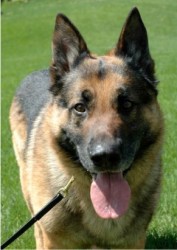As I first started to read this excerpt from The Dogs of Bedlam Farm, I didn’t know who the author was. There was one point in the written piece where I began to have an inkling, but it wasn’t until I got to the very end that I was able to confirm it.
The author is Jon Katz. And while I may not have agreed with Mr. Katz’s point of view in another article I recently posted about, I must say that I enjoyed this excerpt immensely. I got a real sense of the deep, biding love and respect that he holds for his dogs, and I will definitely be looking into more of his work.
Goodbye, Homer
By Jon Katz
Homer was my good dog and everyone else’s, too. He was one of those dogs who fits most people’s image of what a great pet should be. He didn’t chew things he wasn’t supposed to chew or mount strange canine females. He wasn’t overly needy or intrusive, didn’t jump or slobber.
In other words, he did few of the things most dogs naturally love to do. Submissive, wary, and good-natured, he was sent to me in the first place because his breeder believed him to be one of the few dogs who could live peaceably with his tempestuous housemate. This turned out to be true, but it cost Homer a lot.
Studies of submissive dogs show that they often adapt by becoming background pets, living on the periphery, staying out of the way, waiting to edge toward the food bowl or before daring to chew their biscuits. They do what they need to do to stay out of trouble. This is what Homer had learned—what I had allowed to happen.
Trainers and behaviorists know, of course, that the good dog (like the bad dog) is a myth. Dogs are neither good nor bad; they are shaped by all sorts of factors: their mother’s feeding and nurturing habits, life in the litter with their siblings, their first few months in the world, their owner’s instructional methods. They adapt to their environments depending on training and circumstances and on varying degrees of luck, instinct, and skill on the part of human beings. It wasn’t a case of Homer being good or bad but of how well I’d taught him to live in our world.
Like the shy, awkward kid growing up in the shadow of a more charismatic older sibling, Homer lived entirely in the shadow of Orson, my first border collie. You couldn’t help loving Homer, of course. A profoundly amiable creature, he would collapse with joy at the sight of the mailman, his favorite UPS driver, and every other kid getting off a school bus. Each morning, he braved Orson’s possessive wrath to hop onto our bed and wrap himself around my wife Paula’s head for a snuggle. He and Paula were crazy about each other, seeing in each other the stability, predictability, and sanity so often missing around them. Unlike Orson, a pest in his affections who never knew when to quit, Homer was gentle and discreet, crawling up to offer a few licks, then skittering away.
While I did love Homer dearly, I’d known for a while that in some ways our relationship was incomplete, troubled. Although it is heresy to say so, we don’t love all our dogs the same way, any more than we love all people equally. Nor do dogs love us in the uniform, unwavering way often depicted in dog lore. When I first picked Homer up at the Albany airport, he cringed and backed away from me. We’d gotten much closer, but I’d never completely shaken a sense that he didn’t really know what to make of me.
I should have paid more attention to certain idiosyncrasies. Homer was the first dog I ever had, for instance, who rarely stayed in the same room with me. When I was working in my basement study, Orson was always Velcroed to my leg. My third dog, Rose, more independent and less needy, came and went, but continually touched base and checked up on me. Homer usually went upstairs to doze until the next walk or meal.
Some of this, I knew, was the result of our chaotic years with Orson, who for a while had glared and glowered whenever Homer came near me. Orson was a powerful, dominant, and possessive creature, Homer a docile, submissive, and cautious one. Some of it, I was repeatedly told by trainers, was the result of my inadequate or haphazard training.
But some of it, I also believed, belonged to the peculiar realm of chemistry. At the core, I was no longer sure I was really the best owner for Homer; I also wondered if he was the right dog for me. My other dogs and I seemed almost eerily in tune. Things didn’t always go smoothly, but there were few places I wanted to go that didn’t involve Orson and Rose, and vice versa.
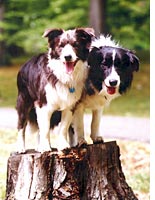 How ironic, given that Homer had generally behaved impeccably. Orson raided the refrigerator, opened screen doors, jumped through windows. He roared off after longhaired shaggy dogs he thought were sheep. He herded bicyclists and skateboarders and scarfed food from babies’ strollers. He escaped over, under, and through fences. I love him beyond words. Homer did none of those things, yet our relationship seemed a struggle.
How ironic, given that Homer had generally behaved impeccably. Orson raided the refrigerator, opened screen doors, jumped through windows. He roared off after longhaired shaggy dogs he thought were sheep. He herded bicyclists and skateboarders and scarfed food from babies’ strollers. He escaped over, under, and through fences. I love him beyond words. Homer did none of those things, yet our relationship seemed a struggle.
Increasingly, Homer lagged behind on walks, left a room if Orson and I were in it, and showed poor name recognition and eye contact, despite hundreds of dollars spent on beef and liver treats. He did not seem—something that only someone who knows and loves a dog well can see—a happy dog.
Could I have trained our way out of this? Sure, especially knowing what I now know. But I didn’t then. Orson took too much time; or perhaps I wasn’t motivated enough.
Herding was the thing Homer most loved, and there was no more companionable grazing dog. He quivered with excitement whenever we pulled into Raspberry Ridge, the farm where we herded sheep for my friend Carolyn. When I said, “Let’s go get the sheep,” Homer exploded with glee and rushed to the barnyard fence. We’d walk the 200 sheep down a forested path to the pasture—they knew the way so well a stuffed dog could have moved them—where Homer and I would sit for hours listening to the herd’s munching. At times, his instincts were nothing less than heroic. One spring evening a ewe broke off from the herd and ran into the woods—strange behavior. Homer followed her, and when I located them, a newborn lamb was nuzzling the startled Homer and the ewe had taken off to rejoin the flock. It took the better part of an hour to identify the proper ewe and bring her and her baby back into the barn for nursing and warmth. Meanwhile, the lamb had imprinted on Homer and tailed him for weeks. Homer looked unnerved but kept an eye on the little guy.
“Away from sheep, however, our troubles persisted”
At some point I’d begun to enter the murky area where the boundary between the human’s issues and the dog’s troubles blur. I became increasingly annoyed with Homer, his avoidance, his lagging, his sniffing at every bush and tree, and, yes, his rejection.
I found myself scolding him, urging him to hurry up on walks, to pay attention. “C’mon, c’mon,” I’d hiss in a voice I never used with any of my other dogs. “Let’s go, let’s get going.”
Many people advised me to stop worrying about Homer. “Look, he’s just a dog, and he’s living a better life than 99.9 percent of the dogs on the planet. Life doesn’t have to be perfect, even for dogs. You do the best you can, and he’s fine.”
For a number of reasons, that didn’t work for me. Does that philosophy really serve the dog, or is it designed to make the human feel better? My duty went deeper than that, I thought. The day I took on this dog, I accepted responsibility for his care. I hadn’t done right by him.
Was he happy? I wasn’t sure. Was he as happy as he deserved to be? I didn’t think so. Was he getting the attention he craved? Did he feel calm and safe? No.
On some level I’d concluded Homer wasn’t good enough. He wasn’t as adventurous as the other two dogs, nor as resilient. He didn’t walk as fast, react as quickly, herd as competently.
“Poor guy, I thought. No wonder he slept in another room”
One of my strategies for Homer was to start plotting activities for just the two of us. We began to leave Rose and Orson behind several times a day, something I should have done much earlier: at dawn, when we trained; then late morning, when we went out to chase balls and Frisbees; and again in the late afternoon, when I began what I called the school-bus ritual. It was a neat idea, better than I first realized.
Homer loved school buses, mostly because kids came pouring off of them, and he loved kids. He was especially fond of one of our neighbors, Max, a sweet 10-year-old with a shy but easygoing nature. In a funny way, he was much like Homer, which is perhaps why the two connected. Homer adored Max from the first, and vice versa, so I thought it would be nice for him to greet Max at the bus stop.
At 3:30 p.m. the bus pulled up to the corner across from our house and a gaggle of kids came thundering out. Homer waited and then went into his patented wriggle when Max disembarked; Max beamed and looked for Homer, knelt down to say hello, gave him a hug. Then Max and Homer would walk the half-block to his house.
By the third day, all I had to say was “Let’s go see Max” and Homer would go nuts, as happy as if there were sheep outside. The other school kids loved Homer, too, and he was nearly drunk with joy from all the attention. The first day or two, he looked nervously around, perhaps waiting for Orson to appear and order him away. But he soon realized that greeting Max’s bus was his daily task, his moment, another form of work but without competition from his siblings or scolding and criticism from me. There was no part of this task that Homer could fail at, and it was delightful to see these two guys fall in love.
It occurred to me, after only a few days, that this was the kind of relationship Homer would thrive on, and the kind I couldn’t provide.
Max’s family was dog-starved. He had a younger sister, Eva. His mother, Sharon, an education specialist, worked at home. His father, Hank, a magazine editor, worked grueling hours in the city but was at home several days during the week. Everybody in the family wanted a dog and talked incessantly about taking one to soccer games and playing with one in the backyard.
In fact, Max asked if Homer could come over and play. So one sunny afternoon, shortly before I was due to head back to Bedlam Farm in West Hebron, N.Y., semi-permanently, I took Homer to Max’s house. I sat on the back porch with Hank, who sensed that there was more to this encounter than an interspecies play date, but I didn’t tell him what was on my mind.
In a week or two I would head north to my farm for the winter. Whatever was going to happen with Homer had to happen soon or else wait for months.
Sitting on the porch, Hank said only how much they all loved Homer, and what a great dog he was. In the yard in front of me, Max and Homer were lying down face-to-face. Max was throwing a ball over Homer’s shoulder; he’d rush to grab the ball, lope back to Max, and slurp his nose.
Homer was having a blast, running in circles, tearing around the yard, smooching Max in between. I’m sure Hank noticed that I was affected by the sight, although I didn’t say why. The reason was that I’d rarely seen Homer so uncomplicatedly happy.
The next few days unraveled me. I knew where this was heading, yet it brought up awful pain and anger, much of it having nothing to do with Homer. The experience of being criticized, abandoned, frightened—all feelings I was thinking about subjecting Homer to or already had—resurfaced in me. I couldn’t sleep. Not even Paula could quite grasp what was happening to me.
So I called the only person I knew who would completely understand: my sister. “Of course I understand that this is unbearable for you,” she said. Yet as a veteran dog rescuer, she also understood the animal nature of dogs. “He’ll be happier. He’ll adapt. And he’ll be close enough so that you and Paula can watch and make sure.” The family I was describing was every dog rescuer’s dream, she pointed out: somebody at home almost all the time, everyone eager for a dog, young kids with energy, always somebody to play with and cuddle.
“He’s had a great life with you,” she told me. “But if he can’t get what he wants with you and you can’t get what you want with him, it’s OK to let him go.”
I asked Hank if he would be willing to have Homer stay there for a few days; if it went well, I said, we could talk about extending the visit further. They’d all love it, he said. I decided to drop Homer off, then take the other two dogs upstate. If things worked out, I would bring Homer up at Christmastime so our family could say its proper farewells. If things didn’t, I’d drive down in a few days and take Homer back. We agreed that Paula would come by to check on things, and that Hank or Sharon and I would talk regularly, as long as necessary for us all to feel at ease and reach a mutual decision.
The next morning, Homer hopped into bed and snuggled with me more affectionately than I could remember. We went for a long walk together before sunrise.
Then I left him in the backyard with Orson and Rose and took his crate to Max’s house down the street, along with a carton of bones, treats, and food. Inside the house, I silently reassembled the crate, lined with his favorite sheepskin and quilt. Then I put Homer on a leash, and Paula and I walked him to what might be his new home. When I handed the leash to Sharon, Homer looked at me nervously; he started to follow me out, then stopped, restrained by the leash. Walking home, I could hear him barking all the way down the block.
That night, on my late-evening walk with Orson and Rose, I saw a dog on a leash coming around the corner. Rose went wild, and Orson began thumping his tail. It was Homer. The sight of somebody else walking my dog, a creature I had loved for several years but had failed, struck deep and hard.
“Is it OK?” yelled Sharon, trying to be sensitive.
“Sure,” I said.
Homer came running over to us, tail wagging, excited and confused. “Goodbye, boy,” I said, at first walking past him, then turning back to lean down, stroke his head, and kiss him on the nose. He seemed anxious and bewildered, started to follow me, yelped in alarm when Sharon drew him away. His yelps sliced through me like bullets. I turned away and kept walking, feeling as if I’d left a part of myself behind. And of course, I had.
The next morning, we returned to Bedlam Farm.
Two months later, Homer came up for Christmas week with Paula. I didn’t think this sort of reunion was something we should do too often. Homer had earned his new life, and returning to ours had to be confusing and difficult for him. Dogs are not like people; they don’t miss what they’ve left behind. They figure out the new rules, check out the food and the folks, and set out to do what they do best—adapt.
The reports from New Jersey had been encouragingly effusive. Everybody loved Homer. Nobody could believe how well-trained he was. Max was in heaven; Homer walked him to the school bus and was waiting for him when he got home. Homer lay next to Sharon all day as she worked in her home office; he dozed on the couch next to Hank while they watched basketball games. He availed himself of a number of sleeping options—sometimes with Hank and Sharon, sometimes with Max, once in a while with Eva. Max and his friends tossed Frisbees and balls for Homer in the yard, and he was the sensation of Max’s soccer team.
When Paula pulled up at Christmas with Homer in the back seat, both Orson and Rose pounced happily on him, and he and I had a joyous reunion. Life quickly grew complex for him, of course. Orson went after his bones, and Rose mercilessly taunted him to play. Within a few hours, he looked beleaguered and wary again.
Over the next few days, though, things sorted themselves out. Rose was more interested in the sheep, Homer was happy to tear through the woods after chipmunks, and Orson generally ignored him. In the early morning, Homer crept up onto our bed as he always had, to bestow a series of quick licks and enjoy a cuddle before retreating—under Orson’s glare—onto the dog bed on the floor.
On the last day of his visit, I took him for what I imagined might be his last adventure with sheep, no small event in the life of a border collie. I had no doubt now that he was a happier dog; that I’d made the right decision. When I opened the gate, Homer tore into the pasture, racing for the ewes. When I called for him to stop, he slowed down. He’d lost a step or two in his cushy suburban lifestyle, and the ewes kept their distance. By the time he caught up with them, he was winded. I came up next to him, put him in a lie-down, and sat scratching his ears while the sheep crunched peacefully on the hillside.
Homer licked my hand and stared at the sheep. It was probably, I thought, the last time we’d spend together like this, for both our sakes. I was grateful for it. Maybe he was, too. At the end of the week, he drove off with Paula, his head propped on the rear window ledge of her car. He was looking back at me.
I’ll always miss Homer’s affectionate heart. But while I regret much about Homer, I don’t regret sending him off to Max and Eva and Sharon and Hank. Things didn’t work out as I’d planned, but at least I didn’t condemn him to the peripheries of love. Because he couldn’t speak, I spoke for him. What I said was: I can’t give you what you need, but I can find you somebody who will. In this, I kept faith with him.
 From The Dogs of Bedlam Farm by Jon Katz. Copyright 2004 Jon Katz. Published by arrangement with Villard Books, an imprint of Random House Publishing Group, a division of Random House Inc. Jon Katz can be reached at jdkat3@aol.com
From The Dogs of Bedlam Farm by Jon Katz. Copyright 2004 Jon Katz. Published by arrangement with Villard Books, an imprint of Random House Publishing Group, a division of Random House Inc. Jon Katz can be reached at jdkat3@aol.com
Illustration by Mark Alan Stamaty; photograph of Homer and Orson © James Lattanzio/Villard.
PURCHASE, THE DOGS OF BEDLAM FARM AT AMAZON ››
Read Full Post »
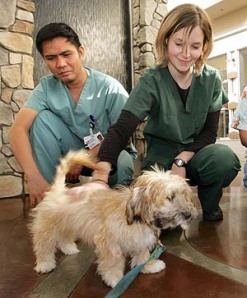

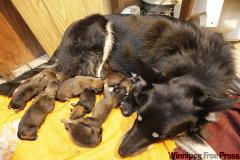
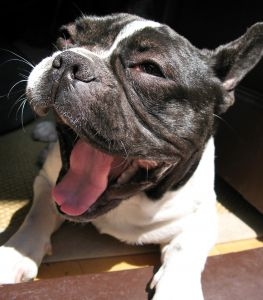
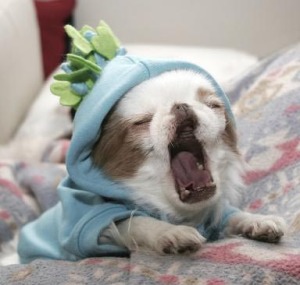



 How ironic, given that Homer had generally behaved impeccably. Orson raided the refrigerator, opened screen doors, jumped through windows. He roared off after longhaired shaggy dogs he thought were sheep. He herded bicyclists and skateboarders and scarfed food from babies’ strollers. He escaped over, under, and through fences. I love him beyond words. Homer did none of those things, yet our relationship seemed a struggle.
How ironic, given that Homer had generally behaved impeccably. Orson raided the refrigerator, opened screen doors, jumped through windows. He roared off after longhaired shaggy dogs he thought were sheep. He herded bicyclists and skateboarders and scarfed food from babies’ strollers. He escaped over, under, and through fences. I love him beyond words. Homer did none of those things, yet our relationship seemed a struggle.
